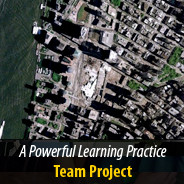As our school looks towards redefining itself, we want to help teachers learn to share and collaborate within our own community, learn to reach beyond our school community, and integrate technology. We want our teachers to develop and share personal learning networks as a resource to help us become life-long learners in all aspects of teaching. We also want to help our staff develop connections within our school and strengthen the communication and collegiality.
1. to understand the importance of developing a Personal Learning Network (PLN)
– Personal Learning Networks can be used as a professional development tool
– making our teachers 21st century educators will make our students 21st century learners
2. to use the school NING for communication within the school
– to develop NING groups for announcements, sharing, & collaboration between subject areas, grade levels, & departments
– as a forum for questions about the implementation of the new school management software
– as a forum for questions, comments, ideas about the new curriulum areas (ie new reading series)
– as a forum for questions, comments, ideas about new technology (smartboards, digital storytelling, websites)
3. to join other NINGs to communicate globally in their subject areas and grade levels
– sharing information from conferences & seminars
– for scheduling conferences & seminars
– as a forum for questions, comments, ideas about new technology (smartboards, digital storytelling, websites)
– to encourage teachers to develop their own Personal Learning Network (PLN) as they become 21st century teachers
4. to introduce teachers to using social networks as a classroom & professional tool
– continue use and development of WikiSpaces
– explore use of Twitter and other social networking sites
– use the school Symbaloo as a platform for resources and organizing frequently used online resources
Our assessments the first year will be to see if the teachers are using the Ning, and then revise our assessment criteria after the first year. We want our teachers to use our Ning to start their PLN within our school. Ultimately, they will use other tools to collaborate with the world!
We will:
1. Use a December 2011 Post-Survey for comparison to our Spring 2011 Pre-Survey results on online usage
2. In July 2012 (2011-2012 school year), we will compare our standarized test results from July 2011 (2010-2011 school year) to see if there is an increase in student performance
3. We will plot the usage of the school NING on a trimester basis (November, March, June)
– January 2011: Faculty meeting- Give brief overview and explanation of the tasks that the PLP teams are involved in this year
– March 2011: Estabilish the INDEPENDENCE NING- get funding and arrange to start Ning
– March/April 2011: Team members join Ning, establish Groups, use creative design elements
– March/April 2011: Survey faculty concerning use of technology
– May 2011: Produce video to attract attention to benefits of school NING
– May 2011: Faculty meeting- Introduce NING- use creative, entertaining methods to generate interest and develop of sense of need within the faculty. Explain to faculty how to join.
– May 2011 – June 2012: Monitor use of NING. Team members and administrators are encouraged to visit atleast one time per week through summer. Continued monitoring will occur on a trimester basis through the 2011-2012 school year.
– August 2011: Faculty Inservice: Touch base with faculty, discuss use of NING for the year, answer questions
– December 2011: Post Survey of faculty
– July 2012: Assessment of student learning/achievement as a result of Faculty NING usage.
What lessons have we learned?:
– From the results of the pre-survey, we confirmed what we suspected, that most of our staff …
â—¦ do not use social networking sites for professional use.
â—¦ do not use an online organizational tool
â—¦ rely on collegues for professional development instead of online resources
â—¦ do not use web based tools in the classroom
Where we are NOW?
Our Independence NING has been funded and created. All PLP group members have joined various groups or forums have been established. Group members are beginning to communicate within our NING. An Independence Symbaloo has been created, various resources by grade level have been established. The link for the Independence NING is centralized on the symbaloo page. Students in middle school have been introduced to symbaloo. We are currently waiting to plan a presentation for the faculty and staff to introduce faculty to the concept of PLNs and the Independence NING.
Pre-survey given to faculty and staff.
Pre-survey results.
Presentation introducing the team’s project.
Other presentations from the team.


